It was a warm spring day in Asheville, North Carolina. I was yanking invasive English ivy off some of my trees when I spotted a huge brown cocoon attached to the trunk of a large cherry tree, only about 4 feet up from the ground. I could tell it was a moth’s cocoon but it seemed far too big. It was as long as my fist from top to bottom, nearly four and a half inches long! What massive creature was tucked away in here waiting to emerge? After a bit of research and a lot of wishful thinking, I decided this must be a Cecropia Moth, the largest moth in North America. I was thrilled! I had never seen one before in my life.
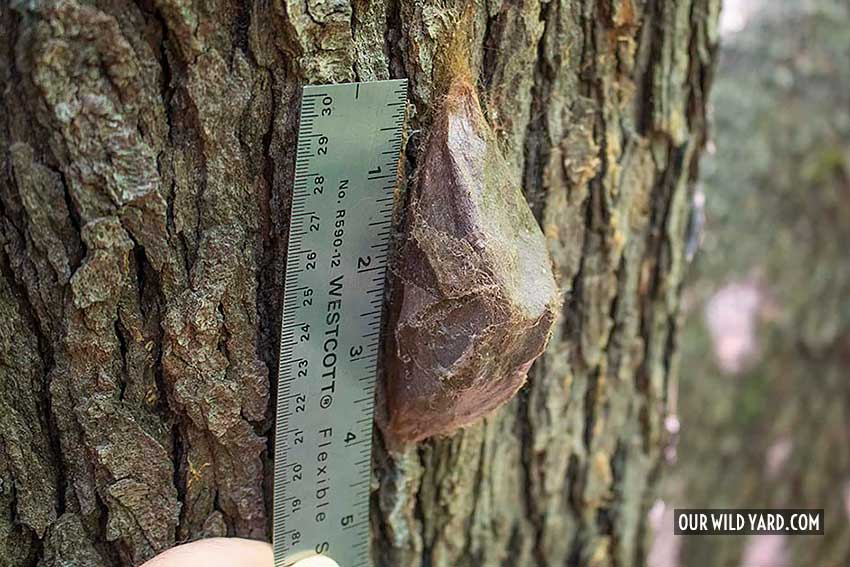
Butterflies seem to get all the attention. That’s because they’re flying around in the sunshine and we can get a good look at them. (Learn how to make a butterfly garden!) But it’s their cousins on the ‘dark side’ who are the real champions of diversity: the moths.
Out of all the Lepidoptera (the order of butterflies and moths) only 10% of species are butterflies, 90% are moths! In fact, there are more than 11,000 species of moths just in North America (with over 160,00 described moth species around the world!) This amazing diversity of North American moths includes a stunning array of beautiful, colorful, and sometimes bizarre animals. Including the biggest of them all: Hyalophora cecropia, known as the Cecropia Moth (or Robin Moth, or Cecropia Silk Moth, or Giant Silk Moth).
I already loved moths, and had seen a couple of the biggest moths in the United States, including a huge Luna Moth just one day earlier:

And a Polyphemus Moth which is probably the second biggest moth in North America. The wingspan can be up to 150mm (almost 6 inches!) which makes it almost a tie with the Cecropia.
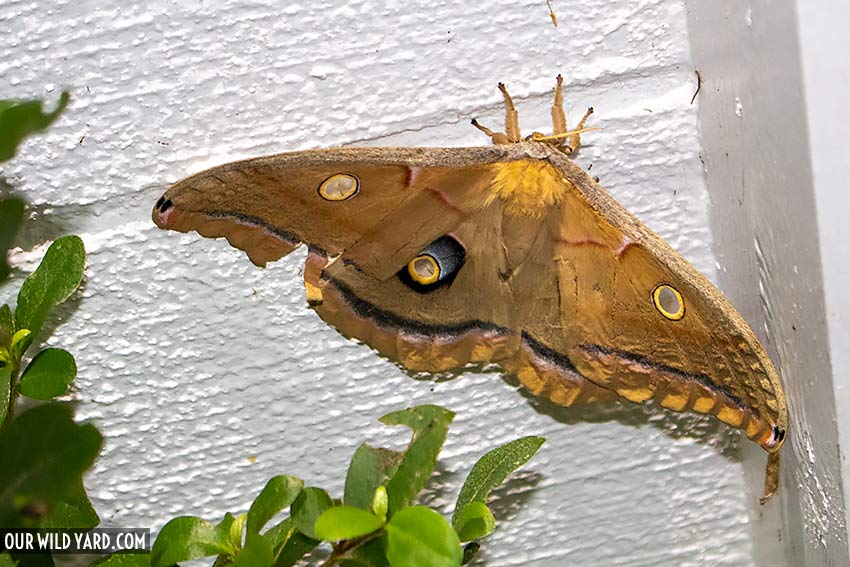
I was super excited at the prospect of finally seeing the biggest moth on the continent. So I waited.
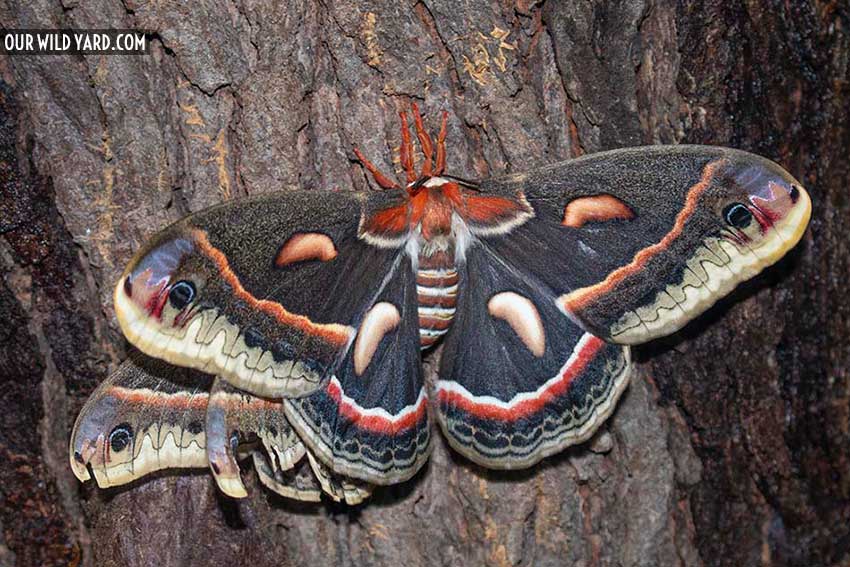
How to See a Moth Emerging From a Cocoon?
I knew from my research that Cecropia Moths emerge from the cocoon in late May or early June. I discovered this huge cocoon in early May so I knew I could have more than a month to wait.
But honestly I had no idea if the pupa was even viable. Maybe it had been parasitized and died? Maybe it was left over from a previous year? And even if it was still alive, how to catch a wild moth emerging from the cocoon? I could have ripped it off the tree and dragged it inside and put in a cage and waited, but I hate to disturb wild animals for my own selfish purposes.
So instead I left it in place and thought about a less-invasive plan. First I set up one of our trail cameras (a Bushnell Natureview HD) and pointed it at the cocoon. Just in case I missed the whole thing, I might get some video clips so I could see what happened.
Secondly, I fantasized about setting up a motion detector to alert me when something moved. I suggested this idea to Cristina and she rolled her eyes so hard that she actually hurt her eyeballs (This is not an exaggeration, she actually said “ow”.)
I was thinking something like the Ideal Security SK602G Motion Detector kit because it’s fairly cheap (about $25), weatherproof, runs on batteries, and is wireless. I could mount one pointing at the tree and then put the alarm unit inside my house, since the tree isn’t too far away. I could choose one of the less offensive sounds like the “soft chime” setting, and just wait. Sadly, I didn’t go for it. So I don’t know if it would have worked. But if I do try it on something else I’ll be sure to make a post about it and let you know. Instead we opted for the good old fashioned “keep an eye on it” method.
A week into June I started to fear that the pupa was dead and maybe I should cut it open to see. But I had to give it more time just in case. Then, on June 9th, Cristina and I were visiting the plants in my native woodland flower garden when Cristina said to me, “Have you checked on the cocoon lately? Why is it turning white?” I glanced at it and realized that the bit of white was actually the edge of a wing. I shouted, “Holy shit, it’s out!” and immediately turned and ran full speed to the house for my camera. It was a Cecropia moth alright. I couldn’t believe it. Cristina had more than made up for her eye-roll by being my cocoon alarm. But before we take a look at this giant moth, a quick look back at her life: the cecropia moth life cycle.
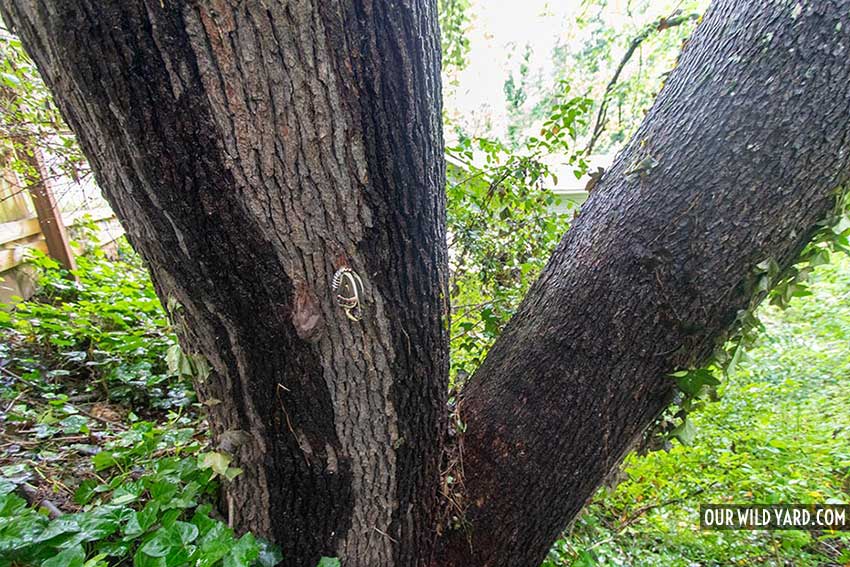
Hyalophora cecropia Life Cycle Part 1: the Cecropia Moth Caterpillar
The Cecropia moth lifespan is one year, meaning they complete an annual life cycle. I first spotted this cocoon in early May. But this moth’s life started nearly a year earlier.
In mid June of last year she was just a tiny egg on a leaf in a cherry tree. Within two weeks (around late June) she hatched out of her little egg as a tiny larva (the larva of a moth or a butterfly is called a caterpillar). She ate the egg shell that she had just hatched from as her first meal, and then started eating the leaf beneath her. She probably had 8 to 10 brothers and sisters emerging from other eggs on the same leaf who also started munching. She may have had hundreds of other brothers and sisters emerging from their own eggs on other leaves in the area. As a cecropia moth caterpillar, her job is to eat and eat and grow and grow. Over the course of about a month, she will shed her skin four times as she grows. Each time she sheds her skin (or “molts“), she enters a new stage called an “instar“.
Caterpillars have five instars. Each instar looks a little different from the previous one and only lasts about a week. She started out in her fist instar as a tiny, black, spiky caterpillar. After molting into the second instar she had a yellow body, but the the spikes were still black. As a third instar larva she was even brighter yellow and her spikes had turned into knobby protrusions called “tubercles”. These tubercles were brightly colored; some were yellow, some were aqua blue/green, and some were bright red, but they still have black spines on top! After molting again and emerging as a fourth instar caterpillar her skin was a light green and she grew bigger and longer and fatter as she ate and ate and ate.

Finally she molted into her fifth instar, a beautiful deep leafy-green color, still covered with brightly-colored tubercles of yellow and blue and red. By this point she was a huge caterpillar about 4 inches long!
Cecropia Moth Life Cycle Part 2: the Pupa & Cocoon
Once she was a full-sized caterpillar in late July, she knew it was time to pupate. That’s the resting stage when a caterpillar transforms into a moth. To become a pupa she first had to find a good place to transform. Most cecropia caterpillars find a thin twig or branch to attach to, but she was different and chose the bark of a wide cherry tree trunk where her cocoon would blend in perfectly. First she spun a silk casing around herself that was firmly attached to the tree. This is called a cocoon.

She can spin silk because she is a silkmoth, a member of the Saturniidae family. Inside this protective layer she spun another silky enclosure around herself. Between the two layer she made a wispy silk stuffing to insulate her during the long winter ahead.

After about 10 days inside this cozy bed, probably some time in early August, she shed her caterpillar skin one last time, and emerged as a pupa, a tight little package where her body undergoes a radical transformation.

For the next ten months she waited in her cocoon. Camouflage is important at this stage to protect her from predators. Gray Squirrels will commonly hunt for the pupae of the giant silkworm moths (the Saturniidae) and according to one study they seem to be able to tell the difference between living and dead pupae. A very cold winter passed by with many freezing nights.
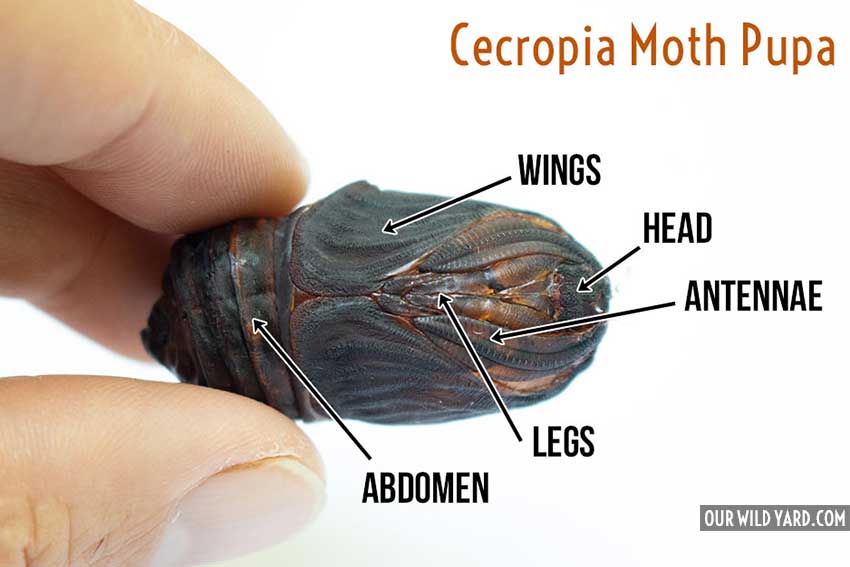
In spring, some ivy grew up around her but she remained safe inside. When the days began to get hot in May her transformation to an adult moth was coming to an end. That’s when I first spotted her cocoon. A month later in early June, after several days of heavy rain, the time was right to emerge.
On June 9th, early in the morning before sunrise, she began to push her way out of the outer skin of her pupa stage. This is called eclosion. As the pupal case split she pushed upward through a small “escape hatch” at the top of the cocoon. She squeezed through the tiny opening, pulled herself free, and emerged as a beautiful adult moth.
She climbed up the rough bark a few inches and began to pump fluid into her wings to expand them. Several hours later they had almost reached their full magnificent size, but they were still a little wrinkly. That’s when Cristina and I spotted her around 12:30 in the afternoon and I almost pooped my pants.
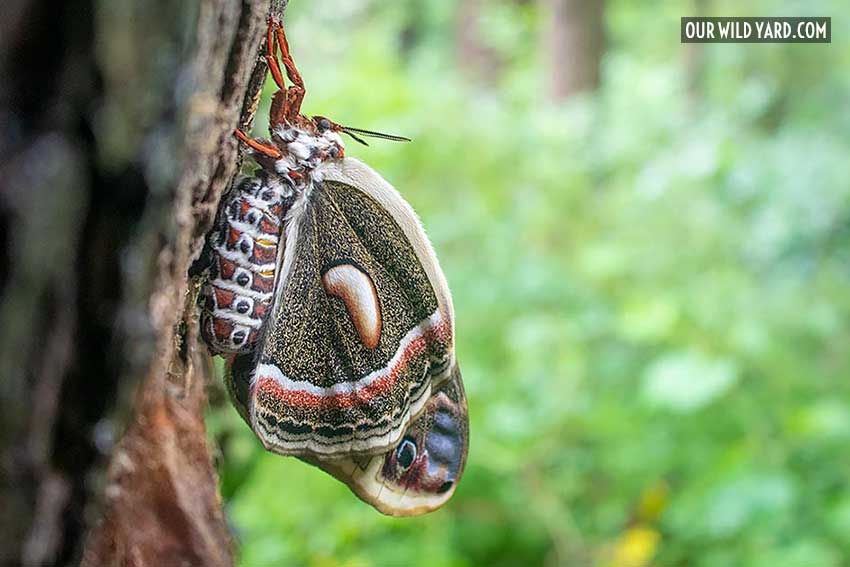
Life Cycle Part 3: The Moth
As soon as I got a close look at her I knew she was a female because of her relatively thin antenna, and her large abdomen. Males have wider, feathery antenna (see how to tell the difference in next section.) Over the next few hours she stayed in the same spot and her wings continued to flatten out.
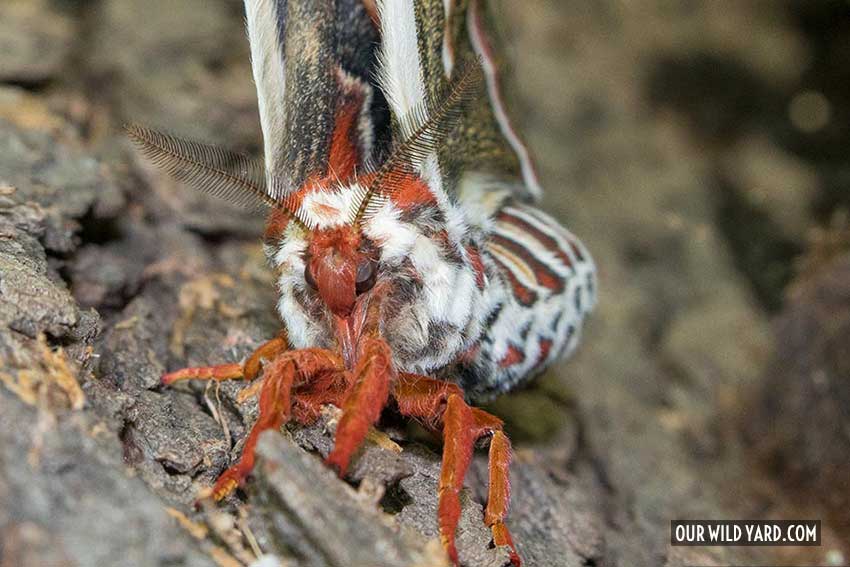
It was so awesome to get a close-up look at this giant insect. The colors and patterns on her huge wings were impressive. There were some beautiful “eye spots” which can help to distract predators by mimicking a large face (much like the owl butterfly of Central America.)
But I think the most surprising thing is her body. Those huge furry red legs look like they would be more at home on a tarantula than on a moth! And the beautiful, soft-looking “fur” on the huge abdomen has even more beautiful colors and patterns! Wow!
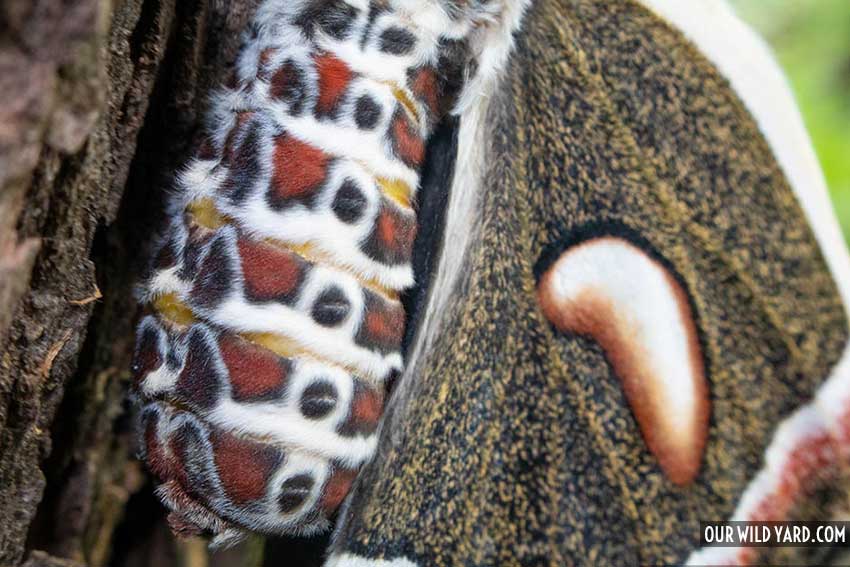
As an adult female cecropia moth, her only goal now is to mate and lay eggs. Because cecropia moths aren’t very abundant, it can be a challenge for males and females to find each other. So how do they do it? The female basically holds still and sends out powerful chemical signals overnight called pheromones. The male detects them with his large antenna over vast distances (some say over a mile, though this is difficult to prove scientifically) and usually finds her just before sunrise.
Cecropia moths have no functional mouthparts or digestive tracts! They cannot eat! That’s why adult cecropia moths only live about 10 days (maybe 2 weeks at the most). They must survive off of energy stored up from the caterpillar stage almost a year earlier! Time is of the essence here. They need to find each other and mate before it’s too late.
So I checked on her throughout the rest of the day while her wings hardened. As the sun began to set I knew she was about to start pumping out pheromones to attract a mate. Good luck beautiful moth!
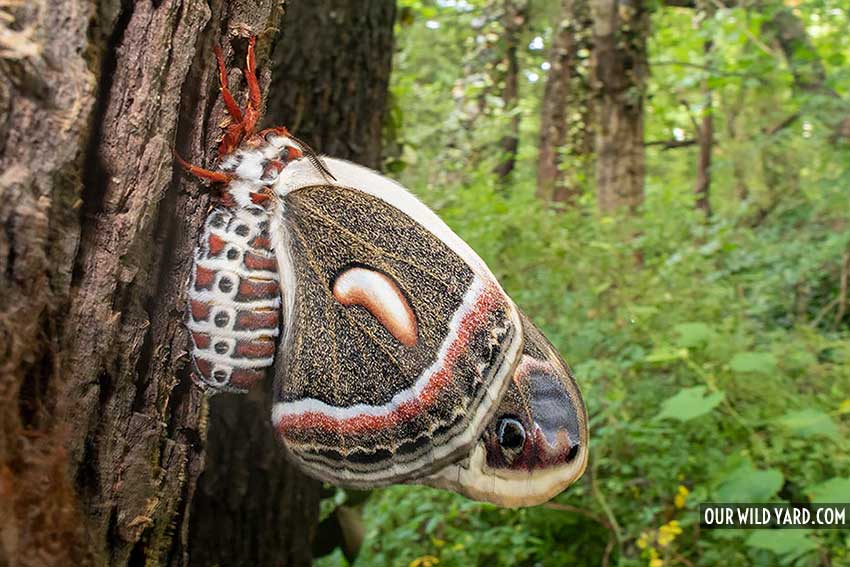
The Difference Between a Male and Female Cecropia Moth
It was a terrible rainy night and I wasn’t feeling very hopeful. How could a male fly in this weather, let alone detect pheromones across huge distances? But still I dragged myself out of bed around 8am to take a peek. And there he was. The two were snuggled side by side on the rough bark of the cherry tree, the ends of their abdomens stuck together. It worked! Our female cecropia moth had found a mate! It seemed like a miracle. I was ecstatic!
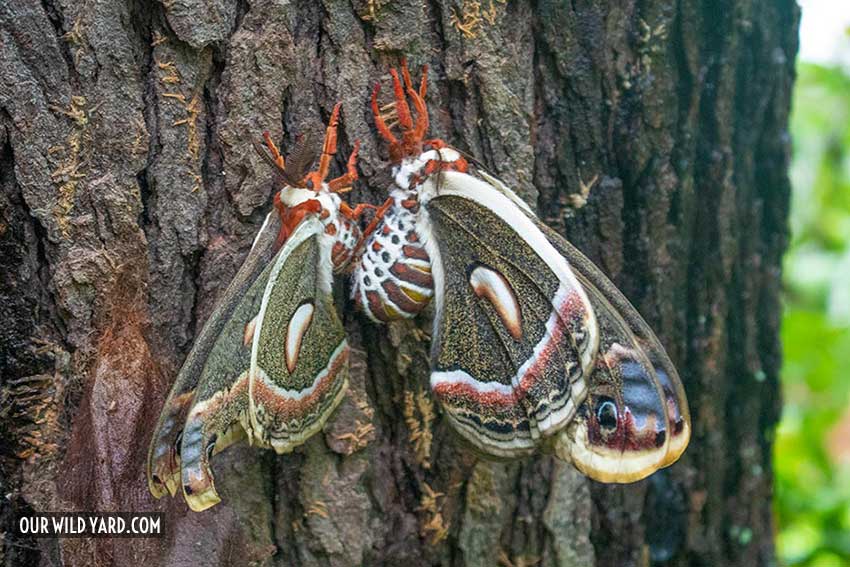
Now I had a chance to observe the differences between a male and a female cecropia moth. The first obvious difference was the antennae. Males have large, feathery-looking antennae that are used for detecting the pheromones of the female. The female antenna are of similar length but thinner.
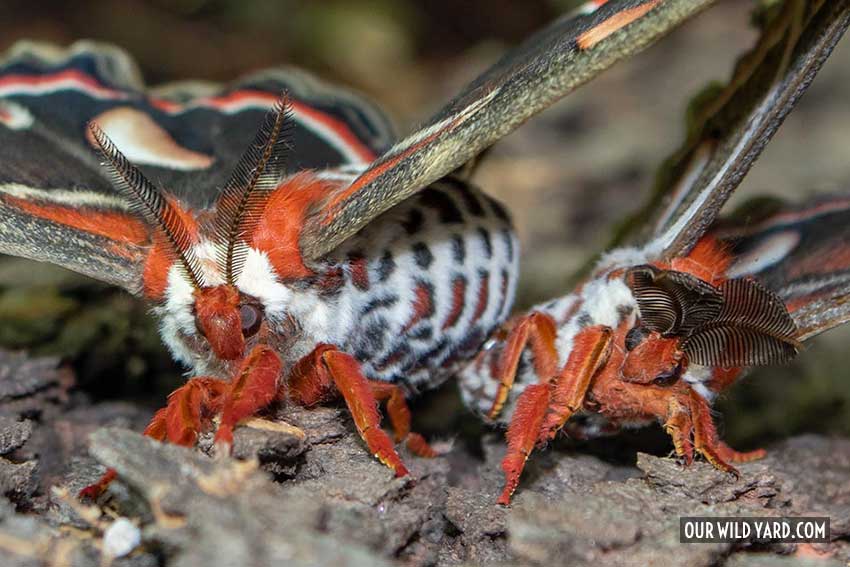

The second obvious difference is that the female’s abdomen is much larger because it is full of eggs. I had read somewhere that male cecropia moths were bigger than females, but that definitely wasn’t the case with these two. Not only was her abdomen much larger but her wings seemed to be larger than his as well.
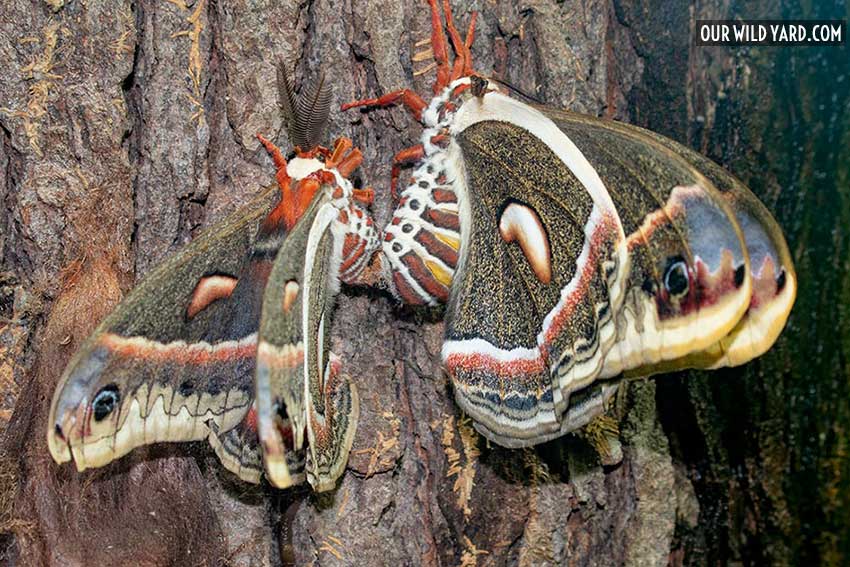
I also noticed that the male had a large bite taken out of one of his wings. Even with his injury he still managed to find his way to her. I snapped a couple photos and left them to their business.
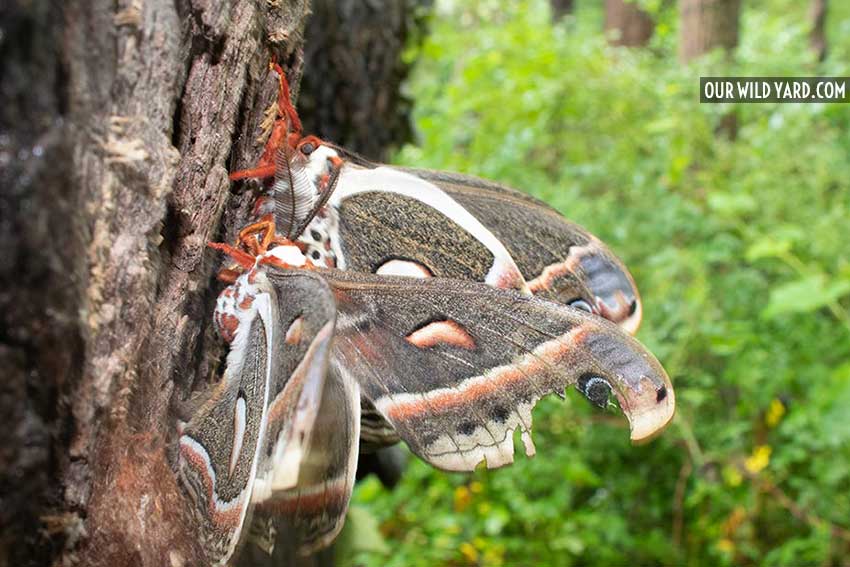
Around 10 am I went to check on them and I noticed the male seemed agitated. On closer inspection I noticed that a little slug had found his way up onto the back of the male cecropia moth! He started frantically trying to wipe the slug off himself but couldn’t reach it. I wanted to help but also didn’t want to scare him off by poking him.
So I ran inside to enlist Cristina’s advice and help (she’s like the insect emergency room around here). But by the time we got back out he had managed to dislodge the slug. Whew! Back to business. You’ll notice in the photo below that he closed up his huge antennae during the slug incident!
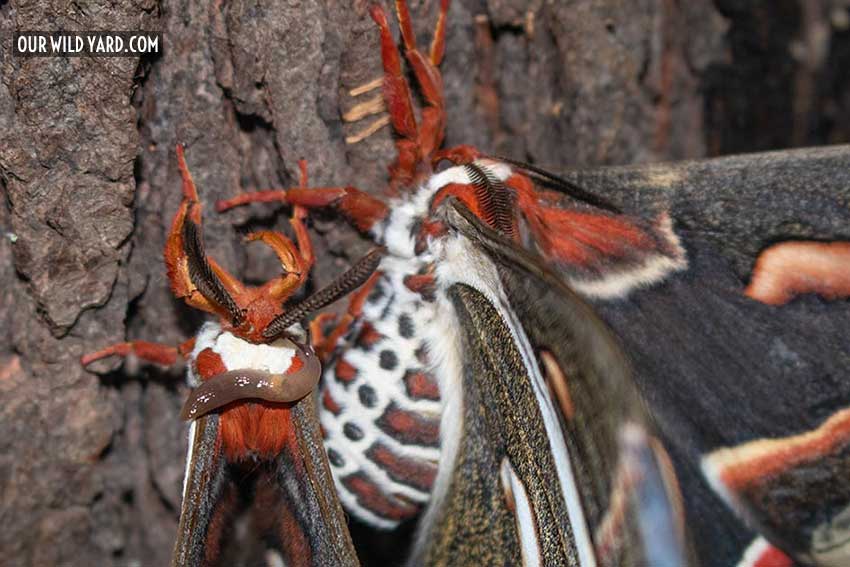
They mated all day long, from sunrise (I presume, I didn’t catch the beginning) until an hour past sunset. I checked at 9pm (15 minutes after sunset) and they were still together. I went out again at 10 pm and they were both gone. Perhaps the male went on to look for another female before his time was up. Meanwhile, our female was taking her first flight in search of a suitable place to lay her eggs. We never saw her again but I hoped she was in the trees above me laying hundreds of eggs and starting the process over again.

I don’t have high hopes of spotting her caterpillars because they could be in any one of dozens of species of potential host trees. Some of the favorite cecropia host plants are maples and cherry trees and we have plenty of both. (One source lists over 75 species of host trees where they’ll lay their eggs!) I’m just happy to know she succeeded and the next generation has begun! Hopefully I’ll discover more cocoons in another month or two!
How Big is a Cecropia Moth? (the non-invasive way to measure)
I knew the Cecropia moth was the largest moth in North America but I wanted to know just how big. When this stunning female Cecropia moth in my yard finally spread her wings while mating (they usually sit with their wings folded together over the back), I really wanted to measure her to see how big her wingspan was. But I also really really didn’t want to spook her while she was mating and wreck her chances of reproducing. Even if she had been alone, I still wouldn’t have laid a ruler across her back to satisfy my selfish desire to measure her.
With a limited time to live (only about 10 days) and a limited amount of energy to spend on her task (mating and laying eggs) I didn’t want her to waste any of that energy by forcing her to fly away in fear or drop to the ground in a defensive reaction (something large silk moths may do). Remember, she cannot eat to recapture that energy! I’ve read that these moths are pretty docile and can be handled by humans without too much stress, but I preferred to take the respectful route and leave her alone.
So instead I came up with a less-invasive way to measure this incredible animal. I photographed her with her wings open from a distance that I knew wasn’t disturbing her, and then I photographed a ruler in the same spot from the same distance and overlaid them in Photoshop. Here’s my process and my result.
Step 1: I took a photo of a ruler against the tree in the general spot where the cecropia moths were mating. I knew she was above and to the right of the cocoon which you can see in the pic below. I used the metric side to be a bit more scientific about it. (Most guidebooks will give you moth wingspan measurements in centimeters.)

Step 2: Next, using Photoshop, (I subscribe to Adobe’s Creative Cloud to use all their apps) I overlaid the photo of the cecropia moth with her wings open onto the top layer. I reduced the transparency of the moth layer to about 60% so I could see through it, and then resized it until the bark features lined up exactly with the ruler photo below it. That way I knew that both layers (the ruler and the moth) were at the exact same scale. I used a soft eraser brush to soften the edges and a hard eraser to exposes the edges of her wingtips for step 4 when I lay her over the ruler. Here’s how that layer looks by itself after resizing.

Step 3: Then I brought the transparency of the moth layer back up to 100% and made sure everything lined up well so I knew I scaled it properly. At this point you’ll see the moth laid over the ruler but, unless you got really lucky, the moth and the ruler won’t be lined up correctly so it’s hard to measure her accurately.
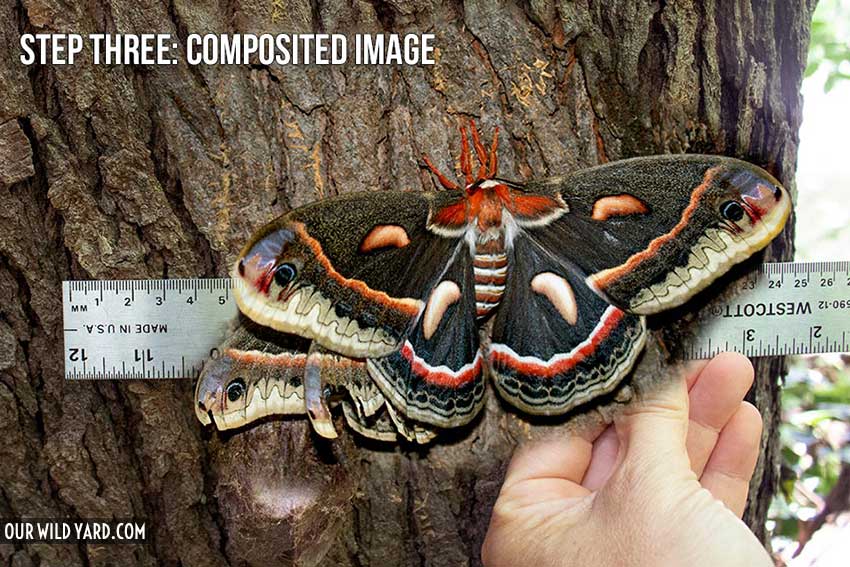
Step 4: To get an accurate measurement of the cecropia moth size, now you’ll need to drag the moth image over the ruler image. I lined up her left wing tip with the 0 mm mark and then looked where her right wing tip wound up.
So How Big is a Cecropia Moth?
Reading my Peterson Field Guide to Moths (Southeastern North America) I learned that the average Cecropia moth wingspan was 110- 150mm. So I was shocked to see that my stunning female cecropia measured in at over a 7 inch wingspan! (185 mm = 7.3 inches). That’s a giant moth!

Have you ever seen a Cecropia in your yard! If so please let me know where and when in the comments below!

Oh my, what a ”wonderful commentary. Now for my thrill! Last Wednesday, 05/18/22] at approx. 6:15 AM, a co-worker came into our workplace. [sewing factory], we begin working at,6:30 AM. ”Hey, there’s a big butterfly on the door, said he”, I screamed, it’s a Cecropia, it has to be! When he said the word big , and being still dawn , I knew it had to be a Cecropia. The wonder of wonders, I am now going on 82, and have only seen 2 others in my life.
The other female coworker, like me who loves nature, said what?
Come on, grab your phone. Well, just about that time our ‘supervisor’ strolled up to us and said ”it’s time to go to work”, I pleaded to go back out and take some photos, She said ”NO”, Yet another co-worker looked at me and said ”go ask you know who”..I did, walking all the way up to the office, all the time thinking, the Cecropia would be gone, For sure I was thankful, the boss said ”yes”… So off we went, phones in hand, He/she was still there.. My co-worker [ age 30, had never seen a Croperia. She was fascinated, as we were both.. I told her, that this was only the third one I had seen in my life. By now, the sun was shining bright. We took some great pics. the dear thing had fallen to the ground, being tangled in some low weeds. Tenderly we got it up. He /she flew away into the sunshine, towards the trees, until we could no longer see it across the field. [ location of the factory is about 1/2 mile, far away from the main street.] We were both happy that we had this chance to see this beautiful moth, but sad thinking, where would it go, what gender was it and she said What will it eat.?? I told her the few facts I knew, like no mouth & living only a few days…A big ”thank you” for ”your post”, giving me and others the whole story i.e. life span. Low and behold, the C. was there on the door the next morning, 6 AM. We were astounded. Of course, given this opportunity, we examined again, marveling at how beautiful it was. Because of your article, I now know this Cecropia was a male , by the antenna being so feathery.
Very sincerely, Sheree
Yes we did!! Female was on the side of our recycle can during an extremely windy, rainy day. Looking today the male has joined her on the receptacle. We live in northeast Ohio. We did our research and discovered the name of the moth. What a beautiful creature.
Yesterday in upstate NY
Have pics. He (I think) was beautiful. We had Luna Moth sitings last spring. Took photos too. Amazing creatures.
I just found my first one hanging on the edge of my siding the first week of June. We live in the thumb of Michigan. I gently put in in a quart glass jar, took pictures and posted on Facebook to ask what it was. Rec’d answers quickly. So amazed at the beauty, colors, and size!! Let her out gently on a maple tree. So beautiful!
I used to find these cocoons all the time in the bushes when I was a kid. Kept one or two in jars all winter to see what came out, then played gently with the moth when it emerged for a bit. We then would let them go; these have always been my favorite moths. I remember learning that the caterpillar’s spicules weren’t dangerous, but they looked like a really good idea to leave alone, so I did. Thought it was the scariest caterpillar I’d ever seen. Haven’t seen one here in Denver for many years and I miss them. We also had tons of ‘Mourning Cloak’ butterflies in our ash trees, one of the most beautiful butterflies ever. Not any more. Too much pesticide, I guess. Maybe the cecropias will come back if I plant another pie cherry tree.
Sunday August 7th 2022 I found for the first time in my life a cecropia caterpillar crawling on the grass of my campsite just outside St Mary’s Ontario. I took a picture and a very short video and then Googled what it might be. Yes it was the cecropia. Then on Thursday I found three more crawling on the grass. I put them in containers and my nine-year-old grandson and I watched them crawl and stretched their bodies up the containers. I was blown away. What were the odds of ever finding more. Then I started looking up and down the maple tree on my site and then I found one in the process of building its cocoon. Later that day my grandson found another cocoon already drying out on the crank handle of my trailer. The next day I found another cocoon in my fern plant as I was watering it. A Park employee took the live caterpillars and the Cocoon off the tree and was going to check with someone from the conservation headquarters. The one on the crank handle will stay but I don’t know what I will do with the other cocoon attached to my fern plant. I hope to be out at my campsite next year and hopefully Witness it emerging from the Cocoon. That’s 7 caterpillars just on my site and not one neighbor has witnessed anything on their properties or trees. What an exciting find this has been.
I found this huge beautiful Caterpillar about 5 years ago, I put it in one of my chicken cages With branches leaves and water to show My mom and my preschool class, and the next day it had already made its cocoon. I left it outside in the elements then when It started snowing I thought something had happened and it had died. I put the cage in my open ended canopy and kind of forgot about all Winter. I don’t even remember what month it was but I’m assuming it was in the Spring I was searching for something in my canopy and I noticed movement, looked over in the cage and there was this huge beautiful moth! I was astonished! Immediately took the cage up on my deck and opened the door. I felt so bad , I had no idea how long it had been in there. She was very docile and I was able to take many, many pictures and videos And then dove into research. I absolutely had to show my mom. she stayed in the cage so I took her over to my mom’s house In the evening for an overnight stay so my mom could watch her. Kept her outside with the door to the cage open. Went home , The very next morning looked out on my deck and laying there was the moth!! I just about dropped my coffee cup!! She was barely moving I thought she was about dead, called my mom In a frenzy, “mom is the moth gone?” Nope she was still there! I couldn’t believe it! so this was a second one. I scooped him up ( Identified that it was a male by his antenna) And drove him over to my mom’s house, we live less than a mile away. In that time the female had flown away I was heartbroken ! I looked and looked and looked and we actually found her! ( I’m getting emotional just reliving this!) Couldn’t believe it! I very gently got the male, whom I thought was barely alive, And tried to set him on on the branch where the female was , the 1st attempt he actually fell, I thought he was dead but I tried again and he actually clung to the branch she was on! We were so hopeful that they would mate and we watched for a long time but He seemed barely alive and neither of them moved. we left and came back a few hours later and To our disbelief they were hooked up. We couldn’t believe it and we’re almost in tears! So incredibly amazing From start to finish the series of events that led to this ending We will never forget! We’re guessing that the male followed her pheromones to my house And then couldn’t find her Because I had taken her to my mom’s (.Besides identifying what kind of moth it was, most of our research was done after everything happened) After taking even more pictures of them together We left them to their privacy and in returning a few hours later both of them were gone, I couldn’t believe that the male was even capable of flying! Growing up on a farm I’ve had many Animal experiences…. but this one takes the cake!
Amazingly beautiful!
You have forgotten the Black Witch Moth!!!
Oooh, that’s a beauty! Thanks for that!
We had one on our store door front on June 22nd, 2023. Later we found one that had perished somehow not sure why. I kept it and am framing it in a shadow box to so my Grandson can see its history and beauty without damaging it. It will hang on the wall in our home.
I saw the Cecropia caterpillar spinning silk and have been watching a cocoon for months now. I’m worried about it being out in the open for the cold spell. Do I need to provide a shelter of some sort for the winter months?
Hi Jennifer, sorry for the slow response. No, you don’t need to provide any shelter; the multiple layers and air pockets in the cocoon do that for them! These moths occur as far north as southern Canada so they ought to be well adapted to cold winters.
Loved the article! Found it when I was trying to figure out what was on my porch. So I have the same moth today in waynesville NC an it is just sitting on my sons camping chair. I didn’t want to scare it so I left it there. It’s been there going on three hours. Its wings are flapping slowly I’m guessing calling a male. But it’s beautiful and now I know so much about them from your article. Thanks for the story!
Congrats Wendy! Maybe you can tell by the antennae if it’s a male or a female!
I found a Cecropia moth a week ago she hatched or whatever u want to call it 3 days ago an when she merged from her cocoon she had one long antenna an one short one an the same with her front legs an her wings I’m not sure what’s up with them I could b mistaken but she hasn’t spread her wings out yet an from the looks of them I think one of her wings has a slit in it an im not sure how to help her or if she can b helped
Hi Ashley, that’s really weird and interesting. I would love to see a photo of the antennae and front legs if you took one (you can send to ourwildyard@gmail.com). If it is a female then I would guess that it wouldn’t impact her ability to mate because she doesn’t have to move, just pump out pheromones. As long as she can fly she should be able to get up to some leaves to lay her eggs. If she can’t fly, then if she does successfully mate you could maybe consider moving her to the branches of a tree. The cecropia has many host trees and shrubs including cherry, maple, and oak so it shouldn’t be hard to find a good one!
We saw a female yesterday and today she was joined by a male. They have been together all day. We’re a bit worried because they moved into the garage…so we don’t want to close the doors in case they want to get out. I don’t want to move them.
We live about an hour north of Toronto Ontario.
They are beautiful!
Hi Heather,
That’s exciting! Sounds like you are near to the northern edge of the range. I agree I wouldn’t close them in just following mating. The female needs to get out onto some trees so she can lay her eggs! I don’t actually know if males will mate again with another female after the first mating, but if so, another good reason to make sure they both get out?
I just found a female Cecropia moth in our yard this morning in a suburb outside of Philadelphia. She is pretty beat up. Her wings are torn in two spots. While broken she is absolutely beautiful.
Thanks for the report Janice. It is amazing they can fly with such thrashed wings isn’t it?